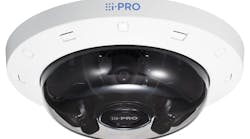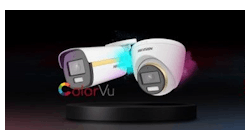The consumer electronics industry clamored over 4K Ultra HDTV (now known simply as 4K) — especially cinematic connoisseurs of the home entertainment experience. Now, the excitement has made its way to the security industry, with the emergence of video surveillance cameras boasting the ability to capture more detailed images than ever before.
Before you dismiss this as hype, consider first what the security industry generally wants to get from its surveillance applications: crystal clear images day or night, more picture detail for positive identification, and advanced analytics that add additional value by delivering business intelligence information. With 4K camera technology, these specialized capabilities help end-users in retail, gaming and other industries obtain ultra-high quality video to protect people, property and assets while improving business operations.
For savvy systems integrators and video surveillance resellers, 4K is a positive way to add value to your arsenal of solutions. It is well-suited to myriad applications, and benefits the end-user in targeted, high-security applications — offering them another way to upgrade image quality and forensic capabilities from recorded or live video in specific areas or environments, with early adopters mixing 4K-capable units with other types of cameras across the enterprise.
What is 4K Video?
When the technology first hit the television market in 2012, the Consumer Electronics Industry (CEA) named “Ultra HD” (UHD) as the de facto industry term; however, similar to how it became common to refer to flat screen resolutions as 720 or 1080, the industry quickly adopted the catchier 4K term.
The rise of 4K, as with other security industry technologies, grew from increasing consumer demand for crisp, higher quality images. The 4K standard is defined and approved by the International Telecommunication Union (ITU) and offers a video resolution of 3840x2160 at 30 frames per second. Like HDTV, UHDTV adheres to specific entertainment industry standards via the Society of Motion Picture & Technology Engineers (SMPTE) as well as ITU-R to ensure and deliver consistent image quality.
With twice the horizontal and vertical resolution of 1080p HDTV, 4K also features:
- Resolution of at least 3840x2160, or 8.3 megapixels
- Frame rate up to 120 fps
- Aspect ratio 16:9
- Color fidelity and a much larger color palette than HDTV
At the 2014 International Consumer Electronics Show — arguably the largest platform for debuting the latest AV and entertainment technologies — 4K television was the notable standout, with nearly every manufacturer announcing this type of display in release or ready for release. With its spectacular picture quality, at four times the pixel density of standard HD, consumers were eager to adopt these new visual showpieces for their homes and offices. In the consumer market, 4K Ultra HD, according to Business Insider Intelligence, rolled out quickly due to palatable pricing and the availability of 4K content from Internet video services.
At ISC West and ASIS 2014, the security industry’s biggest shows, 4K security cameras also took center stage, with many manufacturers releasing new 4K products. During the event, several 4K cameras were announced including a 12MP ULTRA 360 camera that produces a 9MP 3Kx3K fisheye image at 15fps and a 4MP fisheye image at 30fps for incredibly high resolution at standard frame rates. The popular 360-degree camera platform is well-suited for 4K functionality because the high-resolution images produced deliver substantially more picture detail across the broad field of view offered in the panoramic format.
Certainly, the availability of 4K video surveillance cameras will continue to increase along with a broader selection of cameras types and form factors to ensure end-users have the right tool for the right application.
Overcoming the Barriers to 4K Adoption
To truly take advantage of the benefits 4K offers, all aspects of a surveillance system need to be 4K compatible. The next step for the evolution of the technology is the adaptation of the entire security infrastructure to the 4K standard — this includes hardware, video management systems, displays and bandwidth utilization.
There are many considerations in deploying leading edge technology like 4K resolution surveillance cameras. Bandwidth consumption is always critical, but storage at the edge, recording on motion detection or alarm only and the latest compression algorithms are assisting.
Now, H.264 isn’t the only compression technology in town. H.265, also known as High Efficiency Video Coding, is the intended successor to H.264. The H.265 standard was formally published by the ITU in June 2013 and is designed to further improve video quality, doubling the compression ratio of H.264 which will be important as 4K cameras begin to be installed in greater numbers and as part of larger video surveillance and security deployments.
While initially the use of 4K for security applications was hindered by the availability of lenses that could handle the level of resolution required, that is no longer the case. In addition, 4K monitors are available to view the feed from the camera or the storage appliance and advanced image sensors are capable of managing the light required to activate the smaller, more numerous pixels.
For local-based storage, the increased resolution means more bandwidth, and greater storage capacities on servers, while addressing overall network bandwidth capacities and utilization. Thus, edge-ready recording via an SD card and efficient compression methodologies play an increasingly important role in the new world of 4K.
Applications and Early Adopters
4K cameras are an emerging product application and one that can benefit systems integrators by expanding their portfolio of leading-edge technology and allowing them to play a role in helping end-users integrate this promising technology into new and existing systems.
The deployment of 4K technology can be a money maker for systems integrators who learn about the technology and implement it where it is appropriately suited. It is both a technology reducer — it covers a lot of ground and reduces the number of cameras required — and a force multiplier for investigations or virtual patrols.
Potential growth markets and early adopters of the technology include: transportation (rail and transit), smart cities, casinos, retail, stadiums, government/military and financial institutions.
Casinos are interested in the ultra-high resolution cameras on gaming floors to see cards as they are laid on the table and to identify cheaters faster. For stadiums and smart city applications, 4K cameras with onboard analytics or coupled with facial recognition technology (many 4K cameras include analytics) could be used to identify potential threats in large crowds. Indoors, 4K cameras with video motion detection capabilities such as loitering and wrong direction are ideal for monitoring airports as well as large, open warehouses and busy hallways.
In retail environments, heat mapping and people counting capabilities provide insights into staff and customer paths to uncover business optimization and marketing opportunities.
There are many ways for systems integrators to take advantage of the emerging 4K video surveillance market. As with any security technology, let the end-use or final application be your initial guide. Get familiar with potential applications and vertical markets suited to these surveillance solutions. Opportunities for recurring monthly revenue streams are also possible with proactive system maintenance contracts and managing analytics and business intelligence data for the user.
It is all possible with 4K, and it is coming soon to an application near you.
Charles McCready is a senior product specialist for Panasonic System Communications Company. To request more info about the company, please visit www.securityinfowatch.com/10214586.



